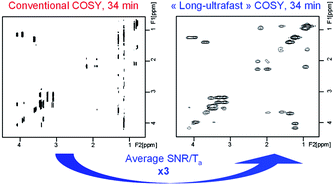“Multi-scan single shot” quantitative 2D NMR: a valuable alternative to fast conventional quantitative 2D NMR
Abstract
Quantitative Ultrafast (

* Corresponding authors
a
Université de Nantes, CNRS, Chimie et Interdisciplinarité : Synthèse, Analyse, Modélisation (CEISAM), UMR 6230, Faculté des Sciences, BP 92208, 2 rue de la Houssinière, Nantes Cedex 03, France
E-mail:
patrick.giraudeau@univ-nantes.fr
Fax: +33 (0)2 51 12 57 12
Tel: +33 (0)2 51 12 57 09
Quantitative Ultrafast (

 Please wait while we load your content...
Something went wrong. Try again?
Please wait while we load your content...
Something went wrong. Try again?
M. Pathan, S. Akoka, I. Tea, B. Charrier and P. Giraudeau, Analyst, 2011, 136, 3157 DOI: 10.1039/C1AN15278E
To request permission to reproduce material from this article, please go to the Copyright Clearance Center request page.
If you are an author contributing to an RSC publication, you do not need to request permission provided correct acknowledgement is given.
If you are the author of this article, you do not need to request permission to reproduce figures and diagrams provided correct acknowledgement is given. If you want to reproduce the whole article in a third-party publication (excluding your thesis/dissertation for which permission is not required) please go to the Copyright Clearance Center request page.
Read more about how to correctly acknowledge RSC content.
 Fetching data from CrossRef.
Fetching data from CrossRef.
This may take some time to load.
Loading related content
